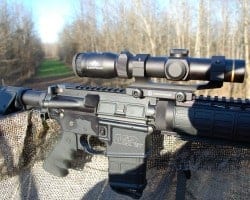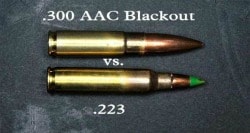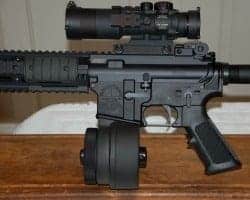Gun enthusiasts love a good campfire argument over different firearms and cartridges. Many, many preppers and survival planners are
SKIP AHEAD
Cartridge Wars
Every gun, rifle, handgun or hunting publication nearly every year runs the same litany of articles comparing the .270 Winchester to the 30-06 Springfield, the 9mm vs the .40 Smith and Wesson or the .45 ACP, the .223 against the 7.62×39, as well as a whole series of pieces doubting or affirming the usefulness of the .38 Special, .357 Magnum, .44 Special, the .41 or .44 Magnums or even the .22 or .22 Magnum rimfires. I am sure you have read some or many of those annual tomes and came away scratching your collective heads. Well, me, too. Truth is they are all good for something. The more the merrier is my motto.
But then, every time a new cartridge development comes on the scene then the debates start up all over again. Personally I think this is healthy for the gun and ammo industry and it also gives shooters, hunters, paper punchers, and even survivalists something new to chew on. Certainly such developments continue to generate new fodder for old crusty outdoor writers like myself. I eat this stuff up quicker than a pepperoni pizza pie, double cheese please.
New Kid on the Block
Well, this kid is not really so new, but for most shooters out there today, it is still in the diaper stage. Most of you preppers even the heavy
Also Read: Survival Debate – .308 vs .223
Now, I’ll not waste your time retelling the history or development of this one. You can do a simple Google search or better yet refer to Wikipedia for a thorough expose’ on the .300 AAC-Blackout and its shadow twin brother the .300 Whisper (not identical twins). Certainly I will not hop down the bunny trail on the .223 cartridge either. Most of you know this one by heart anyway and either used it in a war somewhere, on the ranch, in the pursuit of game, or paper targets. I am not here to sell you on either, but just to point out the doings of each and present some alternatives for your prepping considerations, the good, bad, and ugly.
The Ubiquitous .223 Remington
First, know that as a survival prepper I am a huge fan of the .223-5.56 NATO for all the known reasons it is good and I ignore most its
Without wearing out all the rubber on the tires, the .223 comes in umpteen rifle platforms, the most notable of course, is the AR-15 and clones. That is more than a hundred clones to date. Take or leave it, the fact is the AR-15 is the No. 1 selling and used rifle platform in America. The .223 also comes in a wide variety of bolt action varmint type rifles that can double as a very effective “sniper” rifle for two or four-legged targets. This includes the excellent Ruger Scout rifle which is now available in .223.
Also Read: The Katrina Rifle
Commenting only the on most basic .223/5.56 load and ballistics, this cartridge uses a 55-grain bullet either a FMJ (full metal jacket) or other type of bullet configuration. Its standard muzzle velocity is around 3240 fps (feet per second) with about 1282 foot pounds of muzzle energy. Of course, different loads from different makers may vary from these “paper” graph numbers. Is it the best “killer” in the network of potential survival self-defense cartridges? No. For that you have to step up to the .308 for maximum range and take down capabilities. Will it take down a coyote, wild dog or wild pig harassing your Bug Out camp? Yes, it will. If you are rushed by a cocaine doped zombie charging the front door, is it effective? Creating a third eye-hole in the forehead will certainly go the distance in changing any zombies attack plan. If it should take a whole 30-round magazine, then you have that option, too.
Sweet Baby James, the .300 Blackout
For starters, I simply like the terminology of this new cartridge. I mean what says it all better than using the moniker Blackout? Of
The 300 Blackout is the 7.62×35. In the initial stages of release to the general shooting public there were few factory loads for this cartridge, but that is changing. I can find at least a half dozen new loads that have come out in the past year alone. All this one can assume is driven by an expanding popularity that is resulting in more sales. That is the bottom line when it comes to a cartridge and the guns for it succeeding in the marketplace.
Also Read: The Best Survival Carbine Part 1
Two very popular factory loads for the 300 BO include the Hornady 110 grain V-Max bullet that pops out a muzzle velocity of 2375 fps and a muzzle energy of 1378 foot pounds. The other is the Remington Hog Hammer using a 130 grain Barnes TSX boat tail bullet that generates a MV of 2400 fps and a ME of 1407 foot pounds. Both of these are highly effective rounds for light hunting up to an including white-tailed deer. I have personally harvested deer with the 110 grain Hornady load, one shot kills. I have complete faith in it at reasonable ranges with good bullet placement. One other tidbit of information by way of comparison, the 300 BO generates 16.7 per cent more energy at 300 meters than the 7.62×39 or the AK round. The 300 BO also can utilize subsonic rounds with an installed suppressor if you are inclined to file the ownership paperwork and the NFA $200 application fee with up to a year delay in getting the permit.
Other good news about the 300 BO is that the cartridges fit into standard AR-15 223 magazines. If you already own an AR-15 now, you
Preppers make gear decisions every time they purchase something for stock. If you are planning on the acquisition of any survival weapons as part of your over all SHTF strategy, then now you have an another alternative to consider. Both the .223 and the 300 BO have their attractors and their shortcomings, but either would serve you well. Now, if I threw the 6.8 SPC into this argument mix, you guys would really freak out and the debate would start all over again. Bring it on.
Photos by: Dr. John J. Woods, Adams Arms
300 Blackout: Frequently Asked Questions
Do Special Forces use 300 blackout?
Yes, the Special Forces do use 300 blackout cartridges. In fact, this type of cartridge was actually designed for use in special operations forces, and it is still used by the Special Forces today.
When you look at the 300 blackout cartridges, it is clear to see that they were not designed for use by just anyone with a gun, it is evident that they were designed for those with experience.
300 blackout cartridges are designed in the same style as all of the ammunition that is used by the military with the same case head and taper.
Despite their similarity with military cartridges, these cartridges are not used by the general military, instead they are just used by special forces. So, yes the special forces do use 300 blackout cartridges. In fact, these cartridges were designed with use by the Special Forces in mind.
Why is 300 blackout so expensive?
One of the first things you might notice about 300 blackout bullets is how expensive they are. The main reason that 300 blackout cartridges are so expensive is because they generally aren’t mass-produced for sale.
This means that there is a higher demand for 300 blackout cartridges than there are cartridges available. This accompanied by the fact that this type of cartridge is relatively new in the timescale of cartridge designs means that 300 blackout cartridges generally have a much higher price point than a lot of other cartridges on the market.
So the main reason that 300 blackout cartridges are so expensive is due to their lack of supply and the fact that they are a new design. But the intricacy of the design of these cartridges and the quality of materials used also play a part in making these cartridges so expensive compared to cheaper alternatives.
What was 300 blackout designed for?
As we have said, 300 blackout cartridges were designed with the Special Forces in mind, so they were primarily designed for use in battle and in special force operations.
The main thought that went into designing 300 blackout cartridges is to give extra force and power to the AR platform and give the bullets better penetration. The 300 blackout bullets are most effective in intermediate ranges at getting better penetration without reducing the recoil of the gun.
As well as giving penetration, the 300 blackout bullets were designed for outstanding terminal performance.
So primarily, the 300 blackout bullets were designed as bullets that will perform better, penetrate further and give better accuracy than regular bullets. This is the main reason why 300 blackout cartridges are used by the Special Forces more often than they are used by regular gun users as you do not need this level of accuracy for regular shooting.
How far can you kill a deer with 300 blackout?
Due to their precision and accuracy, a 300 blackout bullet can be used to kill a deer from approximately 100 yards away. 300 blackout cartridges are designed with power in mind and are great at penetrating which is why they can easily kill a deer at 100 yards distance.
But they can also kill a deer from a slightly further distance with some people being able to kill a deer from up to 200 yards away with their 300 blackout cartridges.
At 100 yards, your 300 blackout bullet is almost guaranteed to kill a deer due to the extreme precision and penetration they are able to achieve. So as long as you get a good shot you will be able to kill a deer from 100 yards with your 300 blackout cartridge.
What distance should I zero my 300 blackout?
With all cartridges there is an optimal distance at which you should zero them. When it comes to 300 blackout cartridges this optimal distance is 190 yards.
If you zero your cartridge at this distance then you will be able to shoot as far as possible without having to adjust your sights to dramatically in order to get an accurate shot. With a 300 blackout cartridge, you will generally be within +/- 3 inches of the area in which you were aiming to hit with that shot.
Of course, you can zero your cartridge at different distances to this, but when it comes to 300 blackout cartridges the most effective distance to zero your cartridges is at 190 yards. For other cartridges this will be more or less, but because of their power and force 300 blackout cartridges require a distance of 190 yards.
Will 300 blackout bullets penetrate body armor?
Despite their strength, precision and penetration force, 300 blackout bullets aren’t actually able to penetrate body armor.
Body armor is designed to be extremely strong and almost impenetrable, so it requires an extremely high velocity bullet to be able to penetrate the strong steel that is used to construct the armor.
300 blackout bullets are definitely high velocity but even these powerful bullets are not strong enough to penetrate body armor that is designed to protect you. In fact, there are very few bullets that are powerful enough to penetrate body armor.
So, no 300 blackout bullets generally cannot penetrate body armor. That is assuming that the body armor is of top quality and isn’t already damaged.
Body armor is designed to be extremely strong so that bullets cannot penetrate it, so there are very few bullets that are able to achieve the velocity required to penetrate this armor.






